To the top of the sacred mountain
(Baonghean.vn)In the early days of spring of Quy Ty, in the cool weather, many monks, nuns, Buddhists and tourists came to Thang Thien peak on Dai Hue mountain range (Nam Anh commune, Nam Dan district) to offer incense to Buddha at Dai Tue Pagoda and to hear and see many interesting things...
Dai Tue Pagoda worships Buddha Dai Tue. It is a place of great enlightenment, great wisdom, great courage, selflessness, altruism, sacrifice, all to bring infinite compassion and love, to save the suffering and the needy for living beings. According to Buddhist documents of the Vietnam Buddhist Sangha, this is the only place to worship Buddha Dai Tue.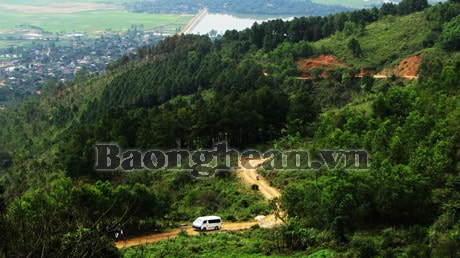
From the foot of the mountain up to Dai Tue Pagoda, the scenery is beautiful everywhere.
Dai Tue Pagoda is associated with many historical stories. According to legend, the pagoda dates back to the reign of King Mai Hac De. In the 15th century, the pagoda was rebuilt by Ho Quy Ly to worship Buddha Dai Tue, because Buddha Dai Tue helped him build Dai Hue citadel as a base to fight against the Ming invaders. The old story says that at that time, Ho Quy Ly ordered the construction of a citadel wall on Dai Hue mountain range. The construction encountered many difficulties and hardships but the citadel could not be built. On the fifth night, he dreamed of Buddha Dai Tue showing him how to build a surrounding citadel. From then on, the construction of the citadel and ramparts was very favorable. Grateful to Buddha, Ho Quy Ly assigned his daughter, Princess Thai Duong, to stay at the pagoda to take care of it, regularly renovate it, and offer incense and worship, to pray for national peace and prosperity...
Until the time of King Quang Trung Nguyen Hue, when on the way to the North to defeat the Qing army (1789), he stopped here to gather one hundred thousand soldiers and organize training in front of the temple yard, so the flat land in front of the temple is still called Bai Tap. The king was advised by a monk at the temple on a strategy to march along the Non Bang route, avoiding the enemy's eyes and ears, shortening the way to Thang Long. Following the monk's advice, Quang Trung quickly marched to Thang Long and defeated two hundred and ninety thousand Qing troops two days ahead of schedule. Returning victorious, the Emperor issued a decree to cut off 20 hectares of rice fields to the temple so that the villagers could take care of incense and worship all year round. Currently, the field at the foot of the mountain is still called Chua field.
The history of Dai Tue Pagoda is interesting, the scenery here is also very charming. The dirt road leading to the pagoda is like a soft silk strip across many mountain slopes, rows of ancient rose trees, hazy villages, rice fields like colorful chessboards... have created long ink paintings. And when standing in the pagoda yard, you can see the winding Lam River, a large area of Nam Dan, Hung Nguyen, Vinh, Nghi Loc and in the distance the Hong Linh, Thien Nhan ranges... surrounding.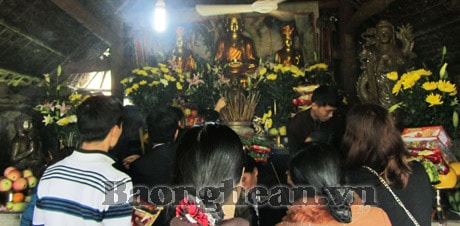
Dai Tue Pagoda is simple but sacred, so many Buddhists and tourists come to offer incense to Buddha.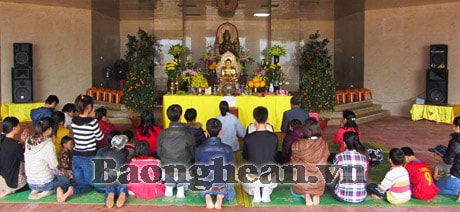
Buddhists worship Buddha at the Three Jewels.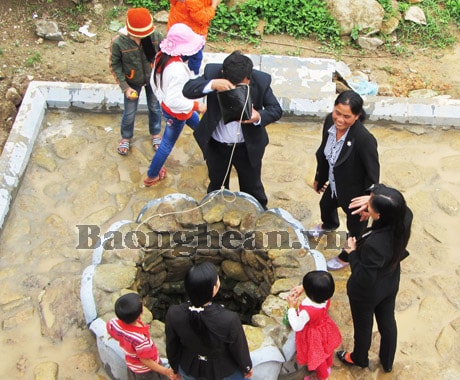
Tourists drink water at the ancient well.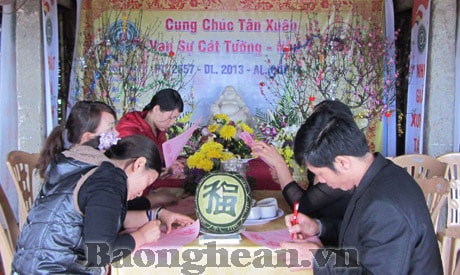
Visitors participate in charity.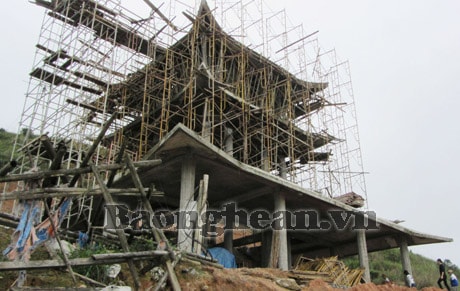
The nine-story stupa and bell tower are under construction.
Coming to Dai Tue Pagoda is coming to a sacred spiritual space, coming to an attractive ecological area. So as Venerable Thich Minh Dinh said: Although the road is still far and dangerous and the pagoda is still in the process of restoration, but in just the first 5 days of the year of Quy Ty, there were more than 4 thousand monks, nuns, Buddhists and tourists coming to offer incense, worship Buddha and visit the pagoda...
Nhat Lan
